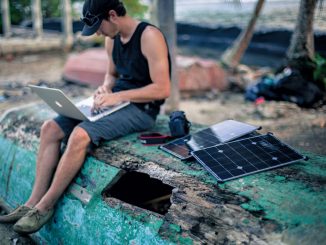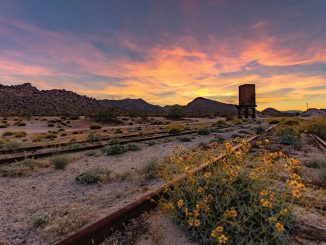
More and more folks are coming to the realization that there might be a time when the only resources they can count on will be their own. This has been driven home recently by the string of back-to-back devastating hurricanes that ravaged the country from Texas to Florida, Puerto Rico to the Virgin Islands, and the wildfires that raged in California and the Northwest. The many terror attacks and the uptick in violent demonstrations in the streets aren’t enhancing peoples’ comfort levels either.
… IN ORDER TO BE READY FOR THE FUTURE, YOU NEED TO EXTRAPOLATE AND SPECULATE BASED ON THE PAST AND CURRENT SITUATIONS AND THE SCENARIOS YOU THINK MIGHT AFFECT YOU.

So far, the only things missing from the collection of dangerous events are a major earthquake and an epic blizzard.
Being Prepared vs. Living Day to Day
All of this swings attention to, and bolsters the ranks of, prepared people who, are tagged as “preppers.” I must point out, however, that today’s “preppers” are yesterday’s “survivalists.” They, in turn, were simply families and other groups of people who, as in the past, planned ahead and took measures to be prepared for the worst that man and Mother Nature could throw at them.

Your trainer should provide examples when they teach. Here, some cooking supplies, lighting and generic pharmaceuticals are part of this display of items that you should store.
In our “just in time” world, that lifestyle of forethought has slipped well into the background, and I’m sure we’re all guilty, to some degree, of a “live for today” existence that means we just run down to the store when we need something.
What happens when we get to the store in a time of need and discover we’re too late and the shelves are bare? We’ve all just seen this result with the news reports from Puerto Rico, Houston and various parts of Florida. To me, that situation defines the term, “disaster.”
So, now that we know it can happen, what can you do about it? Well, you’re already on step one by reading a magazine such as this that covers these disasters and gives you valuable information about how to prepare for, and react to, a wide variety of these scenarios.
Step two is to attend a credible training establishment that will help you get your feet wet or elevate your existing knowledge and skills when it comes to preparing for, and living through, bad times.
I just attended such a class, and I found it to be a really good one.
Training for a Higher Purpose
The Disaster Preparedness class from Firearms Training Associates in Yorba Linda, California, is a full-day endeavor taught by married couple Doug and Lynnette Wallters. They don’t just talk the talk; they also walk the walk and live up to the standards of preparedness they teach.
THE DISASTER PREPAREDNESS CLASS FROM FIREARMS TRAINING ASSOCIATES… IS A FULL-DAY ENDEAVOR TAUGHT BY … DOUG AND LYNNETTE WALLTERS, WHO DON’T JUST TALK THE TALK; THEY ALSO WALK THE WALK …

Shown here are some examples of tarps, plastic sheeting, hand tools, communications gear and, most importantly, the different sources of information you should have available. Reference materials should cover shelter, self-defense, food storage and preparation, and other important survival topics.
If you don’t live in Southern California, where the class is held, you might not be inclined to avail yourself of the same experience I had. However, my report here will take you through the full curriculum that is presented in this seminar and help you know what to look for when you seek training closer to home.

After the food is parceled out into heavy-duty Mylar bags, they are sealed with an iron.
This was a very full eight hours of presentation material that could easily fill my space allocation several times over, so I’ll just hit the highlights and fill in as best I can. You can also check out the Firearms Training Associates website (www.FTATV.com) to get more information on the training.
Variety of Threats
I’ve already mentioned most of the natural disasters—hurricanes, tornados, wildfires and earthquakes—but be sure to include the tidal waves/tsunamis that will accompany an offshore earthquake, as well as blizzards, wildfires, civil unrest and other types of threats, when you consider the type of training you need.

This is a small selection of the essential hand tools you should have available. A proper hand tool kit is indispensable for maintenance, repair and construction in a survival situation.
Other major disasters can come from refinery or chemical plant failures, radiation leaks, or natural or manmade electromagnetic pulses. Don’t forget medical and public health emergencies such as the flu, West Nile virus, Ebola, anthrax, smallpox, viral hemorrhagic fever or other pandemics.

The author learned about the importance of relying on compact, multifunctional tools whenever possible. This camp shovel from Cold Steel is one of the handiest and most useful items you can pack.

Two is one and one is none” is an adage often heard at disaster training events. As a result, the author has a primary 5,500-watt generator and a 3,300-watt backup unit still in the box. The second generator will be used as a loaner for any neighbors who need it (as long as the author’s primary Generac machine is working as it should).
These threats might be harder to recognize at the outset of the emergency and will need to be handled very differently than an environmental disaster or public unrest. While these might seem less threatening and more avoidable than other disasters at first glance, you would be wise to remember that the 1918 flu pandemic killed as many as 100 million people. At that time, the global population was a third of today’s count, and rapid global travel, which accelerates the spread of these diseases, was nonexistent.
Disasters in Perspective
The best way to make some sense out of all these possibilities and how to prepare for them is to categorize them into levels of emergency. Doug and Lynnette use these three levels, and I have included some examples of each:
- Green Event—one to 10 days
Local or regional trigger events: social unrest; localized natural disaster; localized terrorist attack
- Yellow Event—10 to 90 days
Regional or statewide events: large-scale natural disaster; social/economic/government service disruption
- Red Event—three months and longer
Major statewide or national event: social/economic/governmental collapse; major terrorist attack
For the purposes of this article, these are somewhat broad categories, but the timespans are well proven when it comes to recovery. You’re encouraged to fill in each level of emergency with events that are more likely to affect you.
The point here is that in order to be ready for the future, you need to extrapolate and speculate based on the past and current situations and the scenarios you think might affect you. Only then can you begin to create a plan to address those problems.
Setting Realistic Expectations
The two most important elements of success in this effort are that you need to realize that you shouldn’t try to go it alone and that, in many ways, it’s “skills, not stuff” that are most likely to lead to positive outcomes in survival situations.

The trainers at FTA show their students foodstuffs in their original bulk packaging, as well as after it has been divided and resealed for individual use after long-term storage.
When it comes to acquiring the “stuff,” you’ll need to have a plan—and patience—because only the very rich can make it happen all at once. There are companies that offer everything from a truckload of food and medicinal supplies to a complete ready-to-move-in shelter that will shield you from radiation, bio-hazards and rampaging neighbors alike. But those are unattainable for the typical prepper.
IT IS NOT A PRETTY FACT OF LIFE, BUT WHEN THINGS GO SOUTH, YOU CAN COUNT ON CERTAIN ELEMENTS OF SOCIETY TO TAKE THAT AS A CUE TO PREY UPON OTHERS.
Another survivalist dream is a cozy, little secluded retreat on a lake where you can ride out the situation far from the nasty urban areas. However, have you given any real thought to how you’re going to acquire and get to this isolated hideaway when the time comes or how you’re going to defend it from the hordes of desperate folks fleeing those nasty urban areas?

The author learned about some pet medicines that can be purchased; these are just as pure and effective as prescription meds— and at a fraction of the cost!
If you drill down into this scenario, you’ll soon realize that, for most of us, a bug-out plan is less realistic than a bug-in strategy. In addition, you’ll be smart to include others in this plan.
Benefits of Banding Together
To this end, Doug and Lynnette cover how to quietly organize a support group from within your circle of like-minded friends and neighbors that incorporates and leverages everyone’s skills, talents and stores—and does it without a lot of wild-eyed fanfare.

This is a bulk pack of oxygen- absorber packets that are added to food packages to enhance their longevity.
A simple example of this is for several members of the group to volunteer to procure and store water treatment supplies while everyone acquires proper storage equipment. In this way, the group’s members can make use of raw water in nearby ponds, pools or spas when the supply of running water shuts off.

An individual serving of rice that was sealed into a Mylar bag with an oxygenabsorbing packet during the class. We then labelled each bag with the type and amount of food and the date it was packaged— three important elements of the label.
Another group effort that is smart, nonthreatening and a good team-building exercise is to all pitch in to purchase a bulk quantity of foodstuffs and then gather at a “party” to prep it all for distribution and storage. We actually did this in the class.
MORE AND MORE FOLKS ARE COMING TO THE REALIZATION THAT THERE MIGHT BE A TIME WHEN THE ONLY RESOURCES THEY CAN COUNT ON WILL BE THEIR OWN.
Doug brought out a 50-pound bag of rice, and Lynette readied the iron, oxygen desiccant packages and Mylar storage bags. Next, we all tried our hand at putting two cups of rice and a desiccant tab in a storage bag. We rolled out as much air as possible and then closed the bag by ironing shut the Mylar flaps above the zip-lock rib, thereby creating a handy package of sustenance with a 10- to 12-year shelf life. It was a perfect example of how a group of families can pool their resources, time and efforts and accomplish great things.

Students were treated to a tasty lunch that included a selection of stews and other hearty fare. It wasn’t until after everyone had eaten that the instructors informed us the meal consisted of survival foods suggested in the training!
Not only can this approach be used with lots of different food items, you can also apply it to medical and everyday toiletry/personal supplies that will be needed. Something as simple as aspirin or other pain relievers, anti-diarrhea aids, antacids, alcohol, peroxide, bandages and all the other components of a well-stocked first aid kit can be purchased in bulk and parceled out to the group exactly as I’ve described in the rice example above.
EACH ATTENDEE CAME AWAY WITH NEW, USEFUL INFORMATION AND INSIGHTS THAT WILL HELP THEM INCREASE THEIR LEVEL OF PREPAREDNESS AND ENHANCE THEIR FAMILY’S SECURITY.
Many other supplies are also candidates for this approach; charcoal or full propane canisters for cooking come to mind immediately. Lanterns, flashlights, batteries, basic hand tools, solar chargers, generators and fuel are also good candidates for bulk purchases and sharing procedures.
Ultimately, you could find that this process works so well that you might use this “buying group” for group purchases of everyday supplies.

After the food is divided into heavy-duty Mylar bags with an oxygen-absorbing packet, it will have a shelf life of several years.
The simple ability to share certain equipment is another advantage of belonging to such a group. I mentioned generators, but those don’t necessarily need to be one to a household. A group of users might be able to share a few portable generators that can be moved from house to house as needed. Running them long enough at each home to bring refrigerators and freezers back to their coldest and making ice for other storage requirements could be all that is needed for a short-term emergency.
If the situation warrants, you can siphon fuel from vehicles to supplement a supply of 10 gallons of treated, stabilized gas each residence would keep on hand to run those generators for a long time.
Staying Safe and Sound
Considering that the name of this training company is Firearms Training Associates, you might expect that we learned a bit about keeping ourselves safe and secure. This is a subject that merits its own study and treatment, but I will say that organizing neighborhood watch groups, providing useful communication, arming certain groups or committees, and establishing patrol/guard areas are primary aspects of effective protection for members of the group.
We learned to determine how to block off and control the access to our community, which is not “overreach” in any sense of the word. It is not a pretty fact of life, but when things go south, you can count on certain elements of society to take that as a cue to prey upon others. It might be out of desperation—because they were unprepared for the event—or it might simply be a criminally malicious act. However, you and your neighbors need to be ready to respond quickly and effectively when predators approach.
So, considering that Doug and Lynette covered all this and more in much greater detail than I could here, you can easily see why this was a very full eight-hour class. Each attendee came away with new, useful information and insights that will help them increase their level of preparedness and enhance their family’s security.
If you feel your next step is to get some hands-on instruction, but you don’t live in Southern California, you can find many options online. There, you will see private trainers and schools offering classes such as this one from Firearms Training Associates.
You can also check with local resources, such as city or county agencies or your local Red Cross chapter, to see what they might offer. Perhaps the best resource is to check with friends who might have taken classes or know trainers. Their experience will help ensure you find the right match for your skill level and the knowledge you’re seeking.
When you attend a class such as Disaster Preparedness from Firearms Training Associates, you’ll discover that there are few things better than feeling prepared … for whatever might come!
SOURCE
Firearms Training Associates
(714) 701-9918
www.FTATV.com
Editor’s note: A version of this article first appeared in the April, 2018 print issue of American Survival Guide.






Be the first to comment